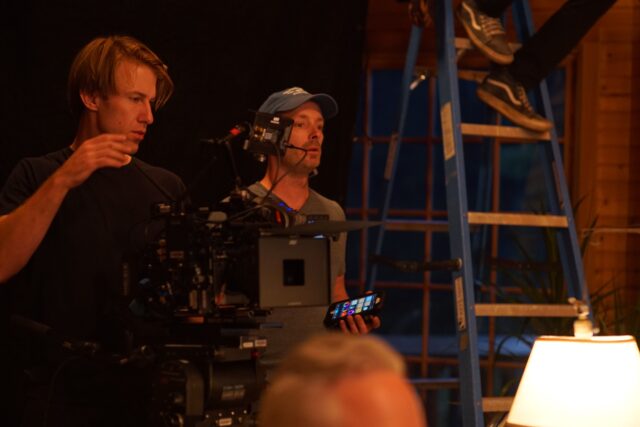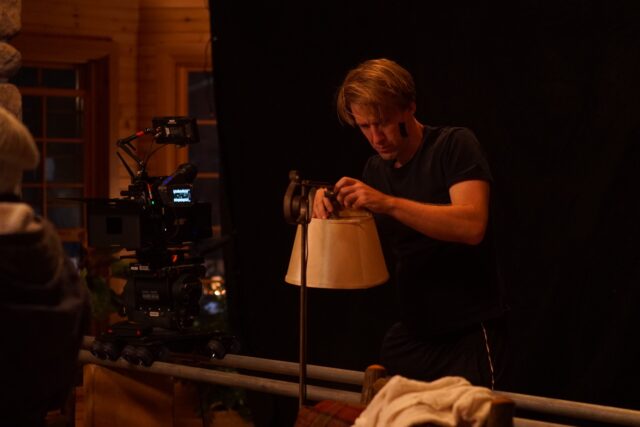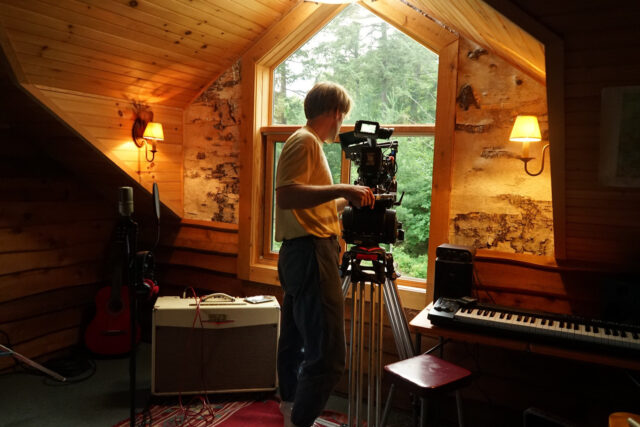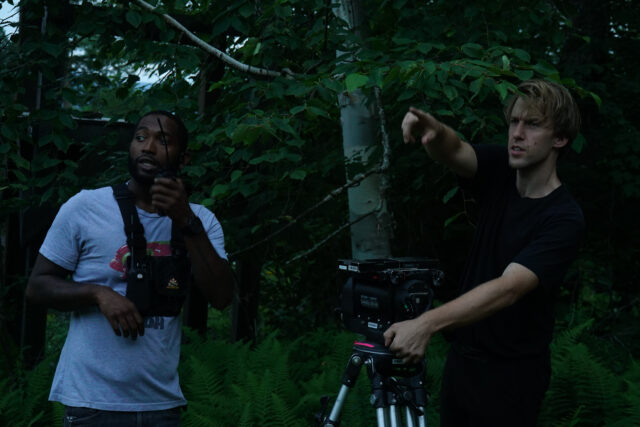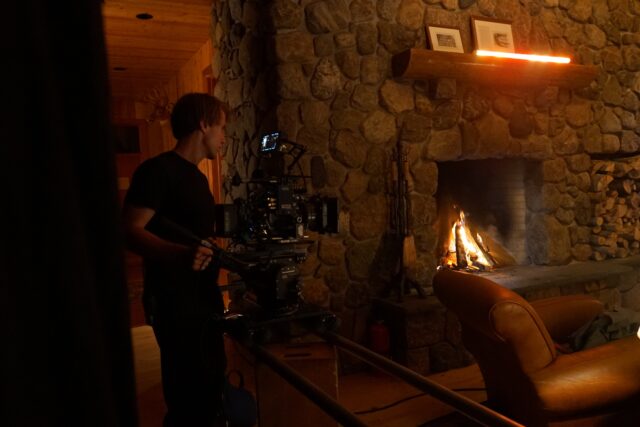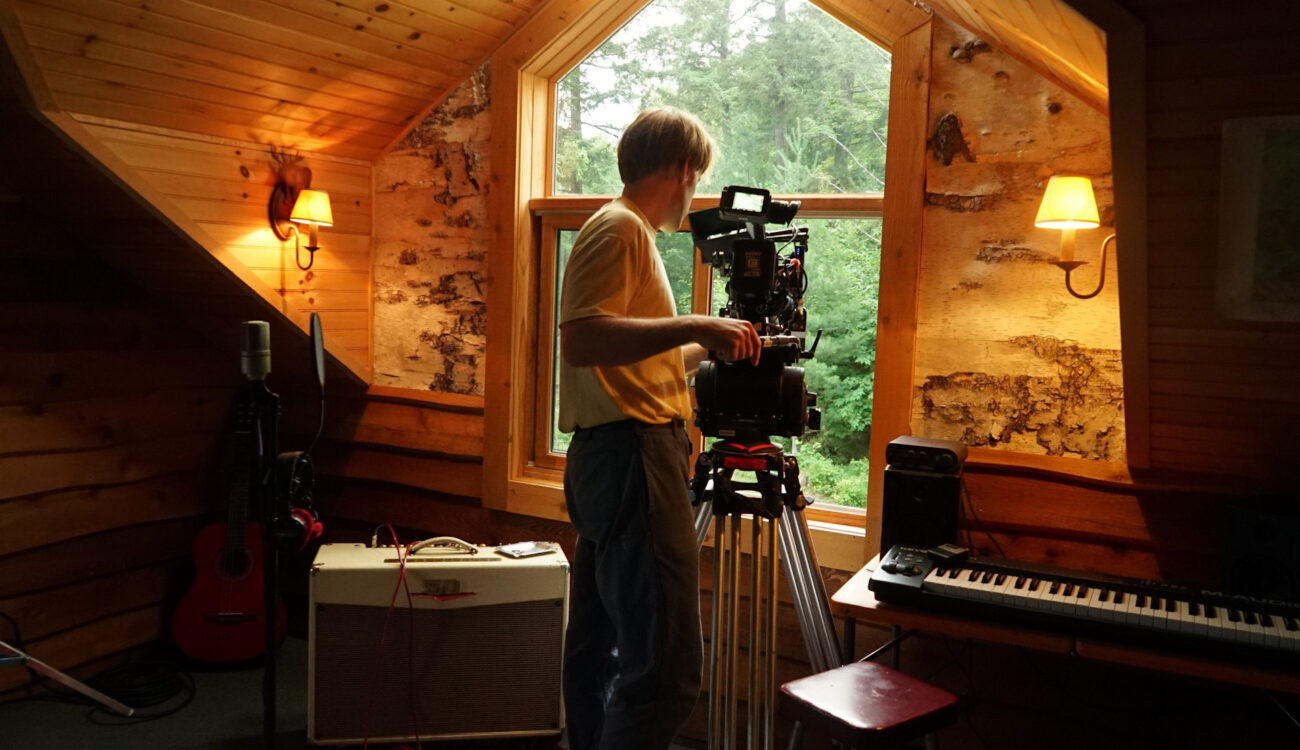
Sure to be a crowd-pleaser amongst filmmakers, Black Bear is a story of a director who blurs the line between art and reality. The protagonist, played by Aubrey Plaza, draws the audience into her search for creative revitalization, which she pursues through the real-life manipulation of a married couple hosting her at a remote lake house in the Adirondacks. Black Bear is one of ten films in the Sundance Film Festival’s NEXT Category. Below is our interview with the movie’s cinematographer, Rob Leitzell.
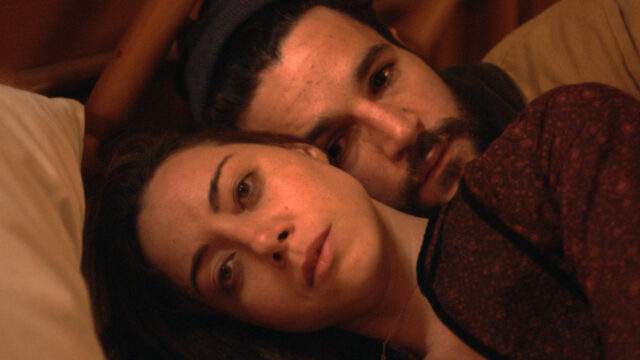
Aubrey Plaza and Christopher Abbott appear in Black Bear. Courtesy of Sundance Institute | photo by Rob Leitzell.
Name: Robert Leitzell
Film: Black Bear (dir.Lawrence Michael Levine)
Competition Category: NEXT
Camera Body: Arri Alexa Mini
Lenses: Cooke Speed Panchro
cinema5D: Where did your connection to cameras start?
RL: My dad was an avid amateur photographer and shot thousands of slides when he traveled for work. He let me use his camera when I was a kid, eventually bought me my own. I kept shooting until college, but I was almost entirely self-taught from Ansel Adams’s books. Learning darkroom printing from his system was a years-long obsession.
cinema5D: So you were artistically inclined from early on then?
RL: As a kid who wanted to be an artist but didn’t show much talent in drawing or painting, I learned to work with my hands: learning carpentry and construction for my school theater. By the time I was in college, I was drafting and designing stage sets. That led me to a job helping a group of young filmmakers design and build sets for an opera they were writing.
cinema5D: What was your major in college?
RL: I somehow majored in “Photography and Performance Art” at Wesleyan University.
cinema5D: And that was where you were building sets?
RL: I built sets from 2003 to 2008 or so…both in college and for a little while after for a friend at Columbia Grad.
cinema5D: Back to the opera-writing filmmakers. Were they your gateway to the filmmaking world?
RL: That experience and the photos I took of their show led me to shoot some of their student films. I found that my experience as a photographer gave me a good start as a cinematographer. I shot short films and music videos for them for a number of years. Then, I worked on the side as a grip to make money, until I enrolled at NYU Grad Film to study directing.
cinema5D: How was your experience in the directing program at NYU?
RL: I met some really talented people and great professors at NYU, but directing stressed me out. I didn’t feel that I had the talent as a writer that NYU wanted out of its directors, so I dropped out and took the opportunity to go and work on Beasts of the Southern Wild with a lot of my friends, which was a pretty convincing life path. My experience in art and design led to a number of jobs as a Technical Director and VFX Cinematographer, which I alternated with more traditional narrative cinematography. For the past few years, I’ve been entirely focused on that more traditional vein of work. I love it, but it has not been a particularly straight path.
cinema5D: What movies have really inspired you? Any favorite DPs or directors?
RL: Early on, (I was inspired) by a lot of black and white masters: Fellini’s 8 1/2. Dreyer’s Passion of Joan of Arc, Murnau’s Sunrise, Fritz Lang’s M, Dziga Vertov’s Man with a Movie Camera…
Then I found color: Terrence Malick and Wong Kar-wai. Their respective Badlands/Days of Heaven/Thin Red Line/The New World and Chungking Express/Happy Together/In the Mood for Love/2046 are I return to pretty frequently. The past five years or so have been Kaurismaki, Cassavettes, Assayas, Apichatong. Those are heavy-hitters for me, but there are more! I love how every film clues me in to new things. Black Bear got me really into Maurice Pialat and Hong Sang-soo.
cinema5D: Were those the directors that Lawrence Michael Levine wanted you to watch for reference?
RL: Lawrence turned me on to the incredible work of Hong Sang-soo, and we watched Maurice Pialat’s work, specifically Loulou and A Nos Amours. We talked a lot about Olivier Assayas, who has a remarkable feel for camera work in all his films (and has had a number of great DP’s). We watched and rewatched a bunch of Assayas films, because he moves the camera like nobody else.
cinema5D: Were the two of you in agreement on what you did and didn’t want?
RL: Honestly, we came into the process with a lot of mutual trust and admiration, and were pretty much on the same page from the beginning.
cinema5D: What’s your advice to directors on how to optimize their relationships with their DPs?
RL: Frequently I will try and watch movies that a director finds inspiring or fascinating or that follow a similar vibe, but visual art of any kind can be useful. What I’m trying to find is a shorthand vocabulary for the film that we can use to get complicated concepts and emotions across quickly and specifically when we are tired or stressed or short on time. Saying “do it like such-and-such would” can save easily ten minutes of conversation if you’ve done your homework in advance together. Shotlisting and storyboarding can be useful, but you always need to be ready to cast off that framework if better opportunities arise.
Having a director who is interested in keeping channels open and unifying the visual approach across the board is a necessary element of making beautiful work. I find that seeing the set dressed is always really inspiring, and always comes, necessarily, pretty late in the game. (I’m lucky enough to be married to a really talented Production Designer and Costume Designer, who has taught me a lot about the process of creativity.)
I have figured out over the years that a lot of the work I’m proudest of, visually, is striking because of a really herculean effort by the other departments on set. Filmmakers are often less fluent and comfortable with the art/costume/hmu side of the process, which I think limits what they are capable of. Being able to collaborate closely with those department heads is an amazing experience for me. I’m not particularly interested in coming on to a film and pursuing a unilateral approach to what I think the cinematography “should be.” I really prefer trying to find a way to get what I see for a film in line with a director’s vision, a PD’s vision, and so on.
cinema5D: Were the people on this particular production team a draw for you to work on Black Bear? RL: It’s tricky, because at the end of the day its the production team who are the people that put together what I need to do my job on set, and in this case, I had never met or worked with anyone on production. (Lawrence and I) had never worked together as Director/DP, but I so liked the way he talked about this movie that I probably would have done it for any budget and any timeline. I just believed in it from the get-go. In this case, I was lucky enough to also have the support and talent of a great cast and crew, which is always special.
cinema5D: What about the script made you believe in it from the ”get-go?”
RL: Normally, I find I need to read a script two or three times to really get a handle on what my approach should be, but in this case, the movie was brilliantly clear on the first read. The script was so emotionally intense and structurally distinct that it grabbed my attention immediately. There were other things, of course. A single location can be a blessing. Having that location on a beautiful lake in upstate New York for the hot months of summer had an appeal to myself and many members of our talented crew.
cinema5D: Let’s talk about preproduction. How did you and Lawrence prepare?
RL: Preproduction was a race. The abbreviated schedule didn’t allow for much of a tech scout, and the location was locked by the time I came on-board. Without having done a director’s scout or having good floorplans, it was pretty difficult to do any particularly elaborate shot-listing. We did go through that process for scenes that demanded a clear approach, just so we had some structure down and could talk through a dry-run of different ways to approach scenes.
Largely, though, we spent a lot of time talking about the feeling of certain scenes, the general language of the film, what kind of shots we liked, what we wanted to avoid. We were ready to work quickly from that sort of general shooting bible on the day.
The limited prep schedule also caused headaches for my wonderful G&E team, working in a difficult location, on a tight schedule: no time to put anything into the walls, window reflections, and a small team to deal with that. They killed it.
cinema5D: Any personal philosophy for running the camera department?
RL: I’m not particularly dogmatic in my approach, and try to stay as flexible as possible. It’s obvious that every film requires different things visually, but I think that’s also true emotionally, and it requires a lot of patience and subtlety to get yourself in the right place. I try to be as friendly and positive on set as possible. I look for crew who are friendly and kind, and who have an artistic and creative mindset. I rely heavily on my crew as active collaborators in a shared vision. At a certain point on any shoot, there will be moments where you will feel your energy lag, or your vision wander, and it’s enormously helpful to have everyone around you understand the beauty and specificity of this film, and this time.
I also know every single mistake in a film will irritate and haunt me for years: through edit, through the color correct, through the premiere, and so on. It’s always worth it to get it right, but it’s never worth it to do so in a way that doesn’t respect the degree of physical work. Filmmaking is emotionally and physically draining. I work hard not to waste the efforts of others, and I try to make time on set comfortable and fun.
cinema5D: Any dealbreakers that will get someone kicked off your team?
RL: I don’t rehire crew who have a bad attitude or who aren’t up to the challenges of the job. When you have somebody with either of those issues, I think it’s important to work to replace them as quickly as possible. Keeping people around who are a liability is unfair to the professionalism and work of everyone else on set.
cinema5D: Fair enough! Why did you decide to go with the Alex Mini?
RL: It’s hard to find a reason not to use the Alexa Mini at the moment. Put aside the technical advantages, which are formidable. It’s also a camera that I know so intimately that it becomes a simple tool, in no way a distraction or piece of tech, and can become almost invisible on set in the hands of a good AC. A good gaffer knows just how far they can push it, a good colorist already has worked that image a hundred different ways. It leaves more mental space to make creative decisions, and in the end is still the loveliest image around.
cinema5D: So it was just a given.
RL: I did test a Venice, and although the dual-ISO would have been useful for us, it’s heavy for handheld, and I wasn’t convinced it was ready for production on a shoot like ours. We were six hours out of the city and without the budget for a second camera body, so any sort of equipment mishap would have been disastrous. I haven’t had an Alexa of any kind fail on me since I began shooting on them, almost a decade ago.
cinema5D: What about the optics?
RL: Choosing Speed Panchros for lenses came after a lot of discussion and testing. I have enough experience to be able to limit my choices down to 3 or 4 families of lenses. Before (making a selection), I go to a rental bay and put a normal length on the camera from each set, maybe a 40mm, and it’s almost always obvious which one has the right feel. I have a set of technical needs that will limit my choices somewhat, but my process for selecting lenses ends up being pretty emotional.
In this case, Speed Panchros were the correct choice. They are flattering to faces; they have lovely fall off and a touch of vignetting. They have a glamour and timelessness that felt right for Black Bear. There are some lengths that I tried to keep out of the film. The wide and long ends of the group are not the best, which ends up locking you into a 32mm to 75mm range, but that’s a pretty happy place for me anyway, and I could never shake how nice the 32 and 40 are.
cinema5D: Did you and Levine stay on the same page through principle photography?
RL: We trusted each other. He was pretty hands-off throughout. Generally speaking, we’d see if the blocking we’d planned could work, watch a rehearsal, have a brief discussion of the shooting strategy, and then from that point on, I gave him the freedom to be 100% consumed by his work with the actors. Maybe once or twice each day he’d come to me for a tweak or suggestion or concern, but otherwise, we kept pretty locked in on our departments.
cinema5D: Did you use any new tech or tools for this shoot?
RL: Our incredible gaffer Derek Horani brought a set of Astera tubes, which are so common on music video and commercial work, but I’d never used them on a narrative project. They were unbelievably helpful, but as with all bits of tech their true utility showed itself in Derek’s exceptional proficiency with them. Being able to run dimmers mid-take, on a small shoot with limited crew and power, is a remarkable ability. I have been a big proponent of the Ratpak AKS system, and always carry one in my kit as well, but on this shoot, the Asteras were king. His team also worked hard every single night to get a really finicky location power system working through endless blackouts and annoyances.
cinema5D: Any go-to accessory or extra luxury you always put in your kit?
RL: I love my on board TVlogic OLED, it’s a real gift to have a relatively color-accurate OLED in a form factor that can be on camera, as when I’m also operating I don’t get to a 17″ that often. Everything else is really up to the package my 1AC thinks is best, based on conversations we have in prep. I never worked as an AC, so I try to be pretty deferential to how they like to build camera and work. I like the camera to be as simple and invisible a tool as possible, and I rely on my AC to tell me how they like to acheive that end.
cinema5D: Talk a little about your approach to the lighting specific to this film. Any particular challenges?
RL: I had two concerns in this film from a lighting standpoint. My first concern was wanting to keep an illusion of moonlight for as much of the film as possible, both interiors and exteriors. We had a beautiful location, but if we couldn’t get exposure on the trees and grounds surrounding the house, we’d never have any life out the windows, and I thought a good deal of the visual interest would be lost. I wanted to be able to motivate light in the exteriors that wasn’t just tungsten wash from the house. Moonlight gave me some freedom to get characters away from buildings and out into the lake: have moments feel private and secluded.
cinema5D: How did you produce the moonlight?
RL: Unfortunately, the driveway to the house was undrivable for a condor, so my G&E team had to work almost exclusively from different sections of the roof on the house, a logistical nightmare that they managed brilliantly every single night.
cinema5D: Roof crew! What was the second challenge?
RL: The second challenge was finding two different looks for the film that were distinct enough to visually match the different emotional arcs, while still having enough of a blend to feel as if they were part of the same film.
cinema5D: What were the two different looks?
RL: Part 1 of the film needed to feel glamorous while also feeling practical-lit. It also includes some very long, complex scenes. In one case, a fifteen-page scene amongst three characters needed to be blocked and shot out in a single 8 or 9 hour night. Relighting in those situations had to be almost immediate. The blocking was loose enough that we couldn’t rely on hitting the same marks each time. It required a lot of subtlety and creativity, and my team were incredible for pulling it off
Part 2 was a verité shoot, again incorporating some really long choreographed sequences. Numerous spots in the film required lighting 3 floors of the house simultaneously, with a mix of units that needed to feel practical in some places, and then like film lights in others…in some moments like moonlight, and at times work for 360-degree shooting.
Throughout the shoot, I was impressed with my gaffer Derek’s ability to modulate lighting within these long scenes, running dimmers and using mobile units to keep the shape on faces, all while maintaining the moody, dim feel throughout.
cinema5D: After all of that, you probably want to protect the image as much as possible. Do you negotiate involvement in post into your contract? What was your involvement in the color process?
RL: I’m getting better about this. Colorists are such an essential part of the creative process, and it is a real make or break decision for a film. More and more I think that keeping budget for a great colorist is an essential choice for a DP, even if it means being short somewhere else on set. In this case, I fought from the day I was hired to have the best colorist around, the lovely Kath Raisch. We got her, and I was happy.I am contractually obligated to be involved in post, yes, and my experiences with Kath make me want to do what I can to keep her involved in films going forward.
What’s your take on where cinematography is heading? Has the bar been raised or are we getting bogged down by the overturn of new tech?
RL: I honestly get pretty bored talking about tech at this point. Manufacturers have a good reason to try to position every new piece of technology as a “game-changer,” but I think that the work of a cinematographer has remained unchanged for a very long time. There is, of course, a requirement of technical proficiency that is demanded of cinematographers, but we also have a lot of support around who can help us get a handle on that stuff. DIT’s, Gaffers, AC’s, Post-Houses. We are pretty seldom alone in these decisions. The one place where we are frequently alone is in trying to find an appropriate and beautiful visual world for a well-written script. I try, in my life and work, to get ever more aware of the emotional, psychological, and narrative elements of our work. I think that developing those capacities is the key to making beautiful and successful films. I only want the tech to disappear more and more, and I think that with the right mindset that’s entirely doable.
cinema5D: What’s your advice to ACs, operators, and younger cinematographers who are trying to level up their careers?
Finding the balance of humility and confidence is really hard when you’re trying to make lovely things. The movies that I find visually stunning are generally made by people with decades of experience, working with brilliant crews at the top of their game, in marvelous locations, with quite a bit of time.
I think it’s important to be a little scared, and use that fear to motivate the endless amount of attention and effort needed to make a work of art in which you can take pride. At the same time, being young and confident (and perhaps a little naive) can also give you the ability to pursue really novel and wild things that somebody a little older and more experienced might never attempt. Find your vision, stay sensitive to it, and pursue it bravely.
